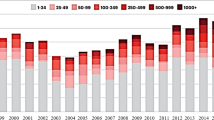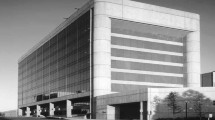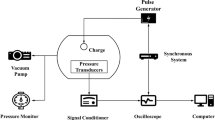Abstract
The detonation of an explosive charge extremely near or above the ground could be devastating causing deformation to the structural frame of the building, cracking of walls, exploding huge areas of windows and shattering all kinds of life saving systems. Depending upon the type and size of explosive used, the possible structural collapse happens when the blast waves produced during explosion, impacting the structure over time. This paper presents to study the characteristics of blast waves and understanding the relationships between various parameters considered in blast loading such as incident overpressure, reflected overpressure, phase duration and scaled distance. Analysis and quantification of uncertainties of the TNT equivalency of different explosives with respect to pressure and impulse observed. Focus was given to formulate an empirical equation from the extracted experimental data considering the influential parameters affecting the blast resistant design that governs the modeling of blast loads. This equation could help in predicting the safe distances beyond which the blasting of different types of explosives would cause minimum impact on the structure. Thus for designing a structure to be resisting blast weight, the foremost important task is to have a realistic overview about the prediction of pressures impacting on a structure and this paper gives essential outline of the detonating effects due to various types of explosives on structures.

















Similar content being viewed by others
References
Hale GC (1935) Explosive. Google Patents
Department of the Army (1990) Structures to resist the effects of accidental explosions. TM 5-1300. U.S. Govt. Printing Office. Washington, D.C.
United States Department of Defense (U.S DoD) (2008) Structures to resist the effects of accidental explosions; report to army armament research and development command, vol 4. United States Department of Defense, Arlington County
Brode HL (1955) Numerical solution of spherical blast waves. J Appl Phys 26(6):766–775
Newmark NM, Hansen RJ (1961) Design of blast resistant structures. In: Harris CM, Crede CE (eds) Shock and vibration handbook, vol 3. McGraw-Hill, New York
Kingery CN (1966) Airblast parameters versus distance for hemi spherical TNT surface bursts. BRL Report No. 1344, Aberdeen Proving Ground
IS 4991-1968 Criteria for blast resistant design of structures for explosives above ground. Bureau of Indian Standards, New Delhi
Kingery CN, Bulmash G (1984) Airblast parameters from TNT spherical air burst and hemispherical surface burst. US Army Armament and Development Center, Ballistic Research Laboratory, Aberdeen Proving Ground, Maryland
Beshara FBA (1992) Modelling of blast loading on aboveground structures-I. General phenomenology and external blast. Comput Struct 51:585–596
Dharaneepathy MV, Keshav Rao MN, Santhakumar AR (1993) Critical distance for blast resistant design. Comput Struct 54(4):587–595
Luccioni BM, Ambrosini RD, Danesi RF (2004) Analysis of building collapse under blast load. Eng Struct 26:63
Ngo T, Mendis P, Gupta A, Ramsay J (2007) Blast loading and blast effects on structures—an overview. The University of Melbourne, Australia, EJSE special issue: loading on structures
Jayasooriya R, Thambiratnam D, Perera N, Kosse V (2009) Damage propagation in reinforced concrete frames under external blast loading. In: 4th international conference on protection of structures against hazards. Hotel Unisplendour Centre, Beijing
Kinney GF, Graham KJ (1985) Explosive shocks in air. Springer, Berlin
Remennikov A (2003) A review of methods for predicting bomb blast effects on buildings. J Battlefield Technol 6(3):5–10
Baker WE, Cox PA, Westine PS, Kulesz JJ, Strehlow RA (1983) Explosion hazards and evaluation. Elsevier Scientific Publishing Company, New York
Hopkinson B (1915) British ordnance board minutes
Goyal A (2008) Blast resistant design: critical issues. In: Proceedings of the sixth structural engineering convection, pp IPXI-1-10, Dec 2008
Karlos V (2013) Calculation of blast loads for application to structural components. Report EUR 26456 EN, European Commission
Mills CA (1987) The design of concrete structure to resist explosions and weapon effects. In: Proceedings of the 1st international conference on concrete for hazard protections, Edinburgh, UK
Jones–Wilkins–Lee (1968) Adiabatic expansion of high explosive detonation products. Technical Report LLNL, UCRL-50422
Smith PD, Hetherington JG (1994) Blast and ballistic loading of structures. Butterworth-Heinemann, Oxford
Mays GC, Smith PD (1995) Blast effects on buildings- design of buildings to optimize resistance to blast loading.
Luccioni B, Ambrosini D, Danesi R (2006) Blast load assessment using hydrocodes. Eng Struct 28:1736–1744
Draganić H, Sigmund V (2012) Blast loading on structures. Techn Gaz 19:643–652
Shi Y, Hao H, Li Z-X (2008) Numerical derivation of pressure-impulse diagrams for prediction of RC column damage to blast loads. Int Impact Eng 35:1213–1227
Samali B et al (2018) Review of the basics of state of the art of blast loading. Asian J Civil Eng 19(7):775–791
Author information
Authors and Affiliations
Corresponding author
Ethics declarations
Conflict of interest
There is no conflict of interest from authors.
Additional information
Publisher's Note
Springer Nature remains neutral with regard to jurisdictional claims in published maps and institutional affiliations.
Rights and permissions
About this article
Cite this article
Sil, A., Phukan, D. Quantification and analysis of air blast load propagation characteristics on structures. J Build Rehabil 4, 24 (2019). https://doi.org/10.1007/s41024-019-0063-7
Received:
Accepted:
Published:
DOI: https://doi.org/10.1007/s41024-019-0063-7




